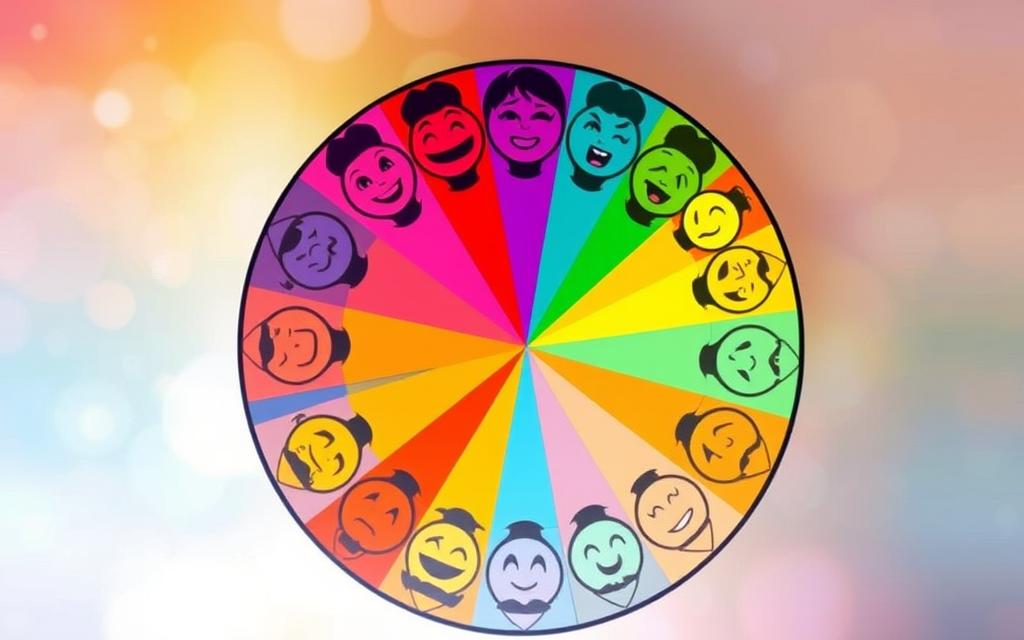Did you know that 98% of our decisions are made by emotions, not logic? This fact comes from a study by the National Institutes of Health. Dr. Herbert Simon, an American Nobel Laureate, said, “To fully understand human rationality, we must look at the role of emotion.” This article will dive into how our feelings guide our choices and shape our lives.
We’ll look at how emotions affect our decision-making. We’ll see how they can change or even decide the outcomes of our daily actions. By understanding these emotional factors, we can learn about the psychological and cognitive biases that influence us.
Let’s start this exciting journey into the impact of emotions on our lives. We’ll cover emotional intelligence, mood control, and how to use emotions for better decision-making. Get ready to learn, feel empowered, and inspired to use your emotions to their full potential.
The Interplay of Emotions and Motivation
As a digital psychology and data science expert, I’ve learned that emotions and motivation blend together. Our emotional drivers push us to take action. Emotions are our body’s way of reacting to things we see as threats or opportunities. This happens online and in real life, making us ready to act or stay back.
Emotions tell our brains about what’s happening and what might happen. They shape how we see things and help us make choices. Knowing how emotions and motivation work together helps us deal with our digital and real lives.
Emotions as Physiological Responses
When we see something our brain calls a threat or opportunity, it changes our body. Our heart beats faster, muscles get tight, and breathing speeds up. These changes are the start of our emotional feelings, getting us ready to face the challenge or step back.
“Emotions are ultimately what drive people to take action.” – Dr. Cugelman
Understanding how emotions affect our motivation helps us get why people behave the way they do. It also shows us how to better handle our digital and real lives. Next, we’ll look at how emotions and making decisions are connected.
How Emotions Influence Behavior
As a professional copywriting journalist, I’ve explored the world of emotions and their big impact on us. Emotions push us to act, shape our choices, and guide us, both knowingly and unknowingly.
Common Emotions that Drive Actions
Emotions lead to many behaviors, based on who we are and the situation. For example, desire might push us to buy something, join a group, or feel excited. Stress could make us buy more, find a supportive group, or freeze because we feel too much.
The Cugelman Emotion Map shows how emotions and actions are linked. It’s a tool that helps us see how our feelings turn into actions.
Looking at the Cugelman Emotion Map helps us understand the emotional impact on our behavior. This knowledge lets us make better choices, handle tough situations, and know the emotions that drive behavior.
The Emotional Drivers of Decision-Making
When I think about decision-making, I see emotions play a big role. Many think emotions get in the way of making rational choices. But, emotions are key to the decision-making process.
Emotions help us quickly make sense of our experiences. They give us a fast way to react to situations. This quick thinking, based on emotional smarts, drives many of our choices. Yet, emotions can also lead to biases that change how we see things and judge them.
Understanding how emotions and decision-making work together is vital. By knowing how emotions in decision-making work, we can use them wisely. This is where emotional intelligence helps. It lets us manage our emotions to make better choices.
“Emotions are not the enemy of rational decision-making, but rather an essential component of it.”
As I delve deeper into decision-making, I believe embracing our emotional side is crucial. It helps us make decisions that are well-rounded and impactful. By balancing rational and emotional aspects, we can fully use our decision-making skills.
| Emotion | Impact on Decision-Making |
|---|---|
| Fear | Can lead to risk-averse and conservative decisions, potentially missing out on opportunities. |
| Anger | Can result in hasty, impulsive decisions made without careful consideration of consequences. |
| Joy | Can inspire creative, ambitious decisions that are driven by optimism and a desire to seize opportunities. |
| Sadness | Can contribute to a more cautious, thoughtful decision-making process, as individuals may be more inclined to consider potential pitfalls. |
how our emotions determine our actions
Our emotions greatly shape what we do and decide. Knowing how emotions and actions connect is key to making good choices. We’ll look at why it’s important to accept and know our feelings. We’ll also see how to beat the emotional biases that affect us.
Welcoming and Identifying Emotions
Don’t ignore your feelings; accept and welcome them. By welcoming and identifying the emotions we feel, we get to know what drives us. This is the start of using our feelings to guide our actions.
Recognizing and Overcoming Emotional Biases
Our feelings can be great guides but can also lead to emotional biases. These biases, like the sunk cost fallacy or the anchoring effect, can warp how we see things and make choices. Knowing about these biases helps us fight their impact. By understanding our emotional biases, we aim for choices that match our real goals and values.
Accepting our emotions and seeing how they affect us is key to self-awareness and smart choices. By recognizing how feelings shape our actions, we can better manage the complex relationship between our feelings and actions. This leads to decisions that are more meaningful and fulfilling.
Regulating Emotions for Effective Decisions
When making decisions, it’s key to know how our feelings and rational thoughts work together. Emotions can help guide us, but they can also cloud our judgment if we let them. Finding a balance between feeling our feelings and thinking things through helps us make better decisions.
Utilizing Emotions as a Guide
Don’t ignore or hide your feelings; use them in making decisions. They offer valuable insights that logic might miss. By understanding our feelings, we can see what drives our choices.
Enlisting Rational Thinking
But, we also need to use our rational thinking. This means looking at all the facts, hearing different views, and making choices based on logic. This way, we make sure our decisions are clear and well-thought-out.
It’s all about finding the right mix of feeling and thinking. Letting our feelings guide us while using our rational thinking. This way, we make choices that feel right and make sense.
| Emotion Regulation Strategies | Rational Decision-Making Techniques |
|---|---|
|
|
“Emotions are not a liability, but a powerful asset in the decision-making process when properly understood and regulated.”
Emotional Intelligence and Decision-Making

Life is complex, and emotional intelligence is a key tool for us. It helps us understand and manage our feelings well. This skill is crucial for making smart and balanced choices. By being mindful and kind, we learn to connect with ourselves and others deeply.
Practicing Mindfulness and Cultivating Compassion
Mindfulness means being fully in the moment and paying attention. It helps us see our feelings without letting them control us. When we make decisions mindfully, we understand our feelings better. This leads to clearer and wiser choices.
Being compassionate towards ourselves and others helps us think about everyone’s well-being. This way, we make choices that are right and fair for all. Emotional intelligence makes us better at making decisions. It helps us make choices that are fulfilling and improve our relationships and life.
“Emotions are the gateway to greater self-awareness and empathy. By practicing mindfulness and cultivating compassion, we can make more informed and balanced decisions.”
Reframing Perspectives and Finding Purpose
Understanding the power of reframing is key when dealing with complex emotions. By changing how we think about things, we can lessen the effect of negative feelings. This opens us up to making choices based on our values.
Reframing means changing our thoughts about a situation on purpose. It helps us move past quick emotional reactions. By asking ourselves, “How else can I see this?” we can change our view. This leads to better, more thoughtful decisions.
But it’s not just about changing our thoughts. We also need to know our long-term goals and what we value most. When we do, we can use our feelings to guide us towards what’s important. This way, we make choices based on our deep values, not just quick feelings.
Reframing and finding our purpose helps us deal with emotions better. It makes our decisions more meaningful and supports our growth over time. This approach leads to a more fulfilling life and personal change.
The Role of Emotions in Rational Decision-Making

Life is complex, and understanding how emotions affect our choices is key. Emotions are a big part of making decisions. They push us to act. By looking into how emotions form and turn into feelings, we can use our emotional smarts to make better choices.
Understanding the Formation of Emotions and Their Translation into Feelings
Every emotional journey starts with something outside us that makes our brain react. This reaction turns into an emotion, which makes our body release hormones. These hormones make us feel what we do. Knowing how emotions turn into feelings helps us understand why we act a certain way. It also helps us use our emotions to make smarter choices.
Utilizing the Emotion Wheel for Self-Awareness and Decision-Making
The Emotion Wheel, created by Paul Ekman, is a great tool for knowing ourselves better and handling our feelings. It shows emotions in two circles: primary emotions like joy and fear, and feelings like content and anxious. Knowing where we stand on this wheel helps us see our thoughts better. This way, we can make choices that match our values and goals.
| Emotion | Feeling |
|---|---|
| Joy | Content |
| Fear | Anxious |
| Anger | Frustrated |
| Sadness | Melancholic |
Using emotions to make rational choices and the Emotion Wheel helps us know ourselves better. This way, we can make choices that fit our values and goals. This approach helps us face life’s challenges with more clarity and emotional smarts.
Strategies for Harnessing Emotions in Decisions
When making decisions, it’s important to use a strategic approach. By using our emotions and thinking logically, we can make better choices. Here are some key strategies to keep in mind:
- Welcome and identify emotions to understand their causes and how they affect our thoughts.
- Regulate emotions to keep a balanced response, so they don’t cloud our judgment.
- Utilize emotions as a guide, but also think rationally to make sure we consider everything.
- Consider the context and gather relevant information to avoid making choices based on emotions alone.
- Cultivate emotional intelligence, mindfulness, and compassion to better handle emotions in decision-making.
- Reframe perspectives and find purpose to make sure our choices match our values and goals.
Using these strategies, we can use our emotions and logic together. This way, we can make decisions that are both effective and thoughtful. It helps us deal with the complex nature of making decisions based on feelings.
| Strategy | Description |
|---|---|
| Welcome and identify emotions | Understanding the root causes and influence of emotions on our thought processes |
| Regulate emotions | Maintaining a balanced and proportional emotional response to prevent overwhelming logical reasoning |
| Utilize emotions as a guide | Incorporating emotions as a valuable input while also relying on rational thinking |
| Consider context and gather information | Avoiding emotional biases by considering the broader context and gathering relevant data |
| Cultivate emotional intelligence | Enhancing self-awareness, mindfulness, and compassion to navigate the interplay of emotions and decision-making |
| Reframe perspectives and find purpose | Aligning decisions with core values and long-term goals to achieve desired outcomes |
“Emotions are not the enemy of rational decision-making, but rather a powerful ally when harnessed effectively.”
Conclusion
Our emotions shape our actions and choices. By understanding how emotions and rational thinking work together, we can make better decisions. This knowledge helps us navigate complex situations with more clarity and purpose.
Being aware of our feelings, practicing mindfulness, and being kind to ourselves are key. These skills help us balance our emotions and rational thoughts. This balance is crucial for making choices that reflect our true values and dreams.
Let’s value the role of emotions in our choices. They connect us deeply to who we are. By using emotions wisely in our decisions, we lead more fulfilling lives. This path might be tough, but it’s important. It’s through embracing all our feelings that we gain the strength to shape our own futures.

